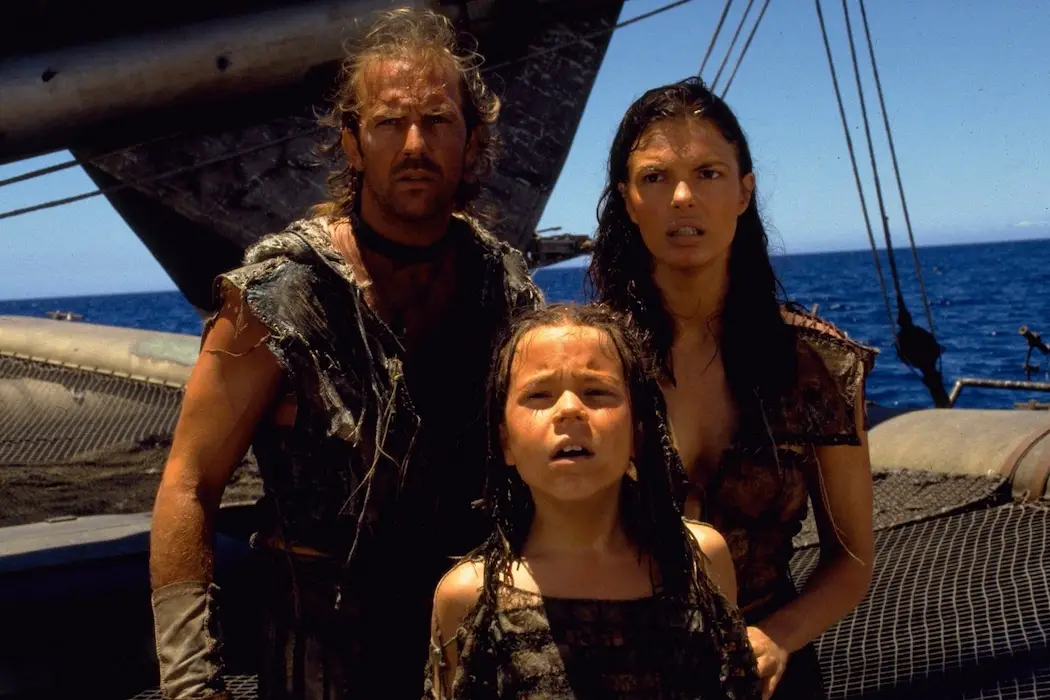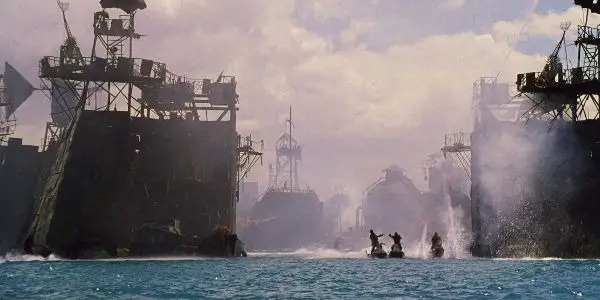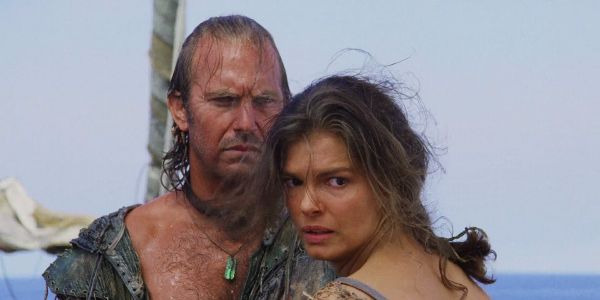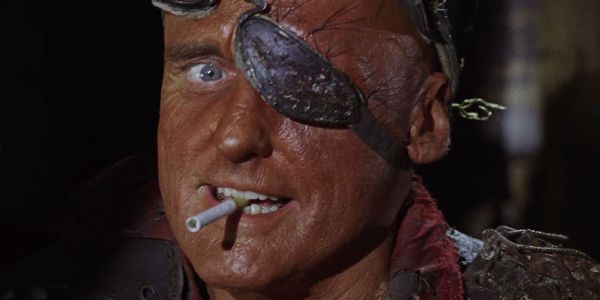A Tepid Defence of WATERWORLD, 25 Years On

Freelance writer based in London. Pacino fanboy and trash connoisseur.
Does anybody still remember Waterworld? Once the most expensive film ever made, Kevin Costner’s aquatic epic only seems to recede further and further as the years go by, its presence eroded by the tides of time. Twenty-five years on, it’s now been reduced to nothing more than cultural debris—mentioned only as a curious piece of pub quiz trivia, or alongside Michael Cimino’s Heaven’s Gate and Elaine May’s Ishtar as notorious flops.
Stormy Seas
Tales of the film’s painfully protracted production, of the carousel of unceremonious arrivals and departures, and of Costner’s despotism as a producer and lead actor, are well known—largely eclipsing the film itself. Composer Mark Isham was ousted from the project after his initial score was rejected by Costner, and a new score was written by James Newton Howard instead. Joss Whedon was brought in to make final revisions to the script, but he was effectively just a conduit through which Costner could impose his own authorial voice-over Peter Rader and David Twohy’s writing. And Kevin Reynolds, the film’s credited director, found himself undermined by Costner’s contributions at every turn, eventually capitulating—leaving Costner to complete the project himself.
The initial budget of $100 million consequently bloated to a staggering $175 million. Still, despite everything, the persistent legend that Waterworld is one of film history’s monumental financial failures isn’t quite true. Certainly, the film punched below its weight at the North American box office, but its overseas haul compensated for its domestic shortcomings. And once home video sales and TV deals were taken into account, Waterworld ultimately emerged afloat in profit—far from a heavyweight hit, but fruitful nonetheless.
So, putting all of that famously turbulent history to one side, how does Waterworld actually hold up today? Has it finally revealed itself as a wrongfully maligned masterpiece, just waiting to be reconsidered and reclaimed like Cimino and May’s visions? Is it a goofy glory that belongs in the so-bad-it’s-good pantheon? Or is it just plain terrible?
The answer, I think, is that watching the film today is to rediscover a sturdy but rather middling treasure, as astonishing as it is underwhelming. Neither a misjudged miracle of mad genius nor an unmitigated catastrophe, it’s a work of reckless ambition and sprawling mediocrity—visually remarkable and emotionally bankrupt.
Waterworld-building
As the film begins, the continents on the Universal Pictures globe disappear beneath the waves, introducing us to a post-apocalypse in which the polar ice caps have melted, covering the entire planet in water. Minuscule fragments of civilisation barely survive on floating structures known as “atolls,” frequently plagued by gas-guzzling marauders known as “Smokers.” There are still people who cling to the myth of “Dryland,” an end to the endless ocean—but it’s a fading hope.
A lonely trimaran sails into view, and onboard is the Mariner (Costner), a weary wanderer without a companion or a name. When we see him for the first time, he’s pissing into a bottle, pumping the urine through some sort of crude filtration apparatus, drinking half of it, and spitting the rest of it out into a potted lime tree. It’s an amusingly unpleasant opening to a blockbuster spectacle, and it’s surprisingly effective in establishing the sort of sordid world-building from which the film sculpts its distinctively dismal environment. Later in the film, the Mariner witnesses a desperate atoll community dumping a corpse into a pool of putrescence to be composted—a large-scale implementation of his own thrifty use of bodily fluids in a self-contained cycle of resources.
It’s in these moments that Waterworld is at its very best—when it’s establishing the scuzzy materials and machinery of its world. The enormous practical atoll set, in particular, is a remarkable feat of production design—a precarious fortress of wood, rope, and scrap metal, as frangible as it is imposing. Everything within its rugged confines feels beaten down and exhausted—from the claustrophobic walkways teeming with bedraggled inhabitants to the almost entirely depleted store selling pretty much nothing other than a few drops of precious potable water. You can practically touch the dirty faces, smell the smoke and decay.

The trimaran set, too, stands out as a thoughtfully crafted extension of the Mariner’s aggressive individualism. Its weaponry reflects his suspicion of, and hostility towards, his fellow seaborne drifters—one of whom steals from him early in the film when he’s momentarily absent. Its various technological modifications, including a wind turbine, mounted onto the mast, and a mechanical system that instantaneously hoists the sail, make it more efficient than any other boat on the water. Wind chimes and a harmonica play a haunting tune on the deck—meagre, melancholy entertainment.
Just as impressive as the production design are the action set pieces, all of which remain among the most beautifully orchestrated marvels of metallic mayhem ever committed to the big screen. Nobody would ever accuse Kevin Reynolds of being a great action director—but here he does exceptional work, managing a myriad of moving parts and cascades of destruction without ever sacrificing clarity. Jet skis, machine guns, trebuchets, flaming arrows, seaplanes, an oil explosion, and a bungee jump from a gas balloon—few big-budget action films can boast such an extravaganza of carnage, and fewer still can boast such a glorious array of practical effects and stunt work. The brutal physicality of Waterworld hasn’t merely survived—if anything, it’s now more staggering than ever, in our age of sanitised superhero violence, soupy cinematography, and weightless CGI.
Character Non-Development
Such praise can’t be offered, however, to the egregious manner in which the film fumbles its promising characters. The Mariner begins as an unrepentant asshole, which makes sense—he’s an “icthyosapien,” a mutant with gills and webbed feet, rejected everywhere and belonging nowhere. When his abnormality is discovered by the people of the atoll, he’s immediately identified as a threat, and sentenced to be thrown into their recycling pit. Humanity judges him to be an outcast freak, so it’s understandable that he matches its hatred.
The Mariner’s escape from the atoll burdens him with two additional passengers: Enola (Tina Majorino), a young girl sought after by the Smokers for the mysterious tattoo on her back, which is said to be a map that shows the way to Dryland; and Helen (Jeanne Tripplehorn), her guardian. With the women on board, the Mariner sustains his unsentimental stance, treating them with unwavering disdain. He cuts their hair against their will as punishment for insubordination, physically abuses Helen, threatens to throw Enola overboard, and then follows through with that threat. He’s a repulsive captain—ruling through humiliation and violence.

The Mariner’s cruelty is actually quite riveting—it darkens Costner‘s star power and elevates the protagonist above every other figure of menace in the film. Enola and Helen soon learn that being stuck in a dying community besieged by murderers is bad, but being stuck on open water with a fish-man who hates everything is even worse. There’s an entire palette of moral shades to play with here.
Frustratingly, Waterworld paints in flat tones instead—the Mariner’s antiheroism lapses into simplistic heroism in the laziest, most nauseating way possible. Instead of being forced to actively interrogate his own actions, he’s passively softened into a surrogate family man by the growing threat of the Deacon (Dennis Hopper), the comically theatrical leader of the Smokers. The Mariner’s crimes are washed away because the crazy jet ski pirate is somehow more dangerous, I guess.
It’s a pathetic excuse for an arc, and its inadequacy is only exacerbated by the film’s staunch refusal to develop Enola and Helen beyond one dimension. Enola’s perspective, in particular, would surely be a compelling angle from which to approach this derivative maritime Mad Max material. There’s ample opportunity here to look deeper, to see this terrifyingly primal world through the uncorrupted eyes of a child who can’t possibly grasp the heaviness of her own existence, the burden of the ink on her back.
Yet the film squanders every last drop of potential, insisting upon flattening both women into ragdolls for the coma-inducing, but apparently infinitely more interesting Mariner, to fling around. Neither Enola nor Helen exist as individuals—they exist merely as devices, designed to demonstrate the Mariner’s growth without him ever actually doing anything beyond making a few perfunctory gestures towards paternal warmth. They exist for no reason other than to find him enraging at first, and then eventually endearing.
As soon as the Mariner surrenders his villainy to the Deacon, all of the film’s tension dissipates—the genuine danger of the Mariner’s misanthropy is usurped by a force of evil too clownish to take seriously. That’s not to say that Hopper‘s scabrous, chain-smoking bandit isn’t an enjoyable antagonist. The actor taps directly into his reservoirs of demented Frank Booth energy, delivering a deliciously vexed and vulgar performance that burns through the screen for a while. The Smokers themselves are a lot of fun, too, chugging booze and burning rubber aboard the immobilised Exxon Valdez, revelling in the filth and grease with which their vicious little world is caked.

In another film, the Smokers would probably offer more than enough primal delights to satisfyingly fill the bad guy position. But Waterworld promises so much more in the Mariner—a morally nebulous savage, whose alienation fuels cold brutality more terrifying than anything a conventional villain could possibly muster. The uncomplicated lunacy of the Deacon and his minions eventually wears thin, and the gaping chasm left by the Mariner’s unconvincing redemption comes into sharp focus.
Conclusion
The wreckage of Waterworld is salvageable, then, not as a great film, but as a stunning gamble—a thoroughly enthralling monument to the sort of grand audacity that we simply don’t see anymore in Hollywood. Above all else, the film stands in bold defiance of the soporific cowardice that pervades so much of modern blockbuster filmmaking. It’s grisly, muscular, explosive entertainment, replete with detailed craftsmanship that makes it feel wonderfully distinctive, not algorithmic, and anonymous. It’s big, bruising—and occasionally, despite its many glaring deficiencies, it flirts with brilliance.
Do you think that Waterworld is underappreciated? Let us know in the comments below!
Watch Waterworld
Does content like this matter to you?
Become a Member and support film journalism. Unlock access to all of Film Inquiry`s great articles. Join a community of like-minded readers who are passionate about cinema - get access to our private members Network, give back to independent filmmakers, and more.













